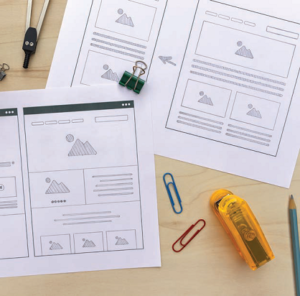
Patricia Tyrrell, leading designer and chairwoman of the Garden and Landscape Designers Association, applies her critical eye, rational thinking and creative soul to her own practice and sets out a number of goals for 2017 – goals we should all heed
Sometimes I think I’m held back by my own success. I always have projects on the go and am constantly being pulled this way and that. I love it really, but my busyness comes at a cost, and there is rarely time to sit back and take stock, to strengthen my good practices and address my weaknesses. As business picked up last summer after the recession, new work piled on top of work that had been on the back burner, thus creating a perfect storm. A whole year went by, running from computer to project with no time for anything else. I promised myself that 2017 would be different and have been working towards that goal, though for a long time it felt like I was swimming towards an island called ‘More Time’ which was gently drifting away. But now I feel that I have finally reached it and it has
been worth the effort. It is giving me a chance to stand back and think about which path to take.
I think Socrates’ famous quote that ‘the unexamined life is not worth living’ applies to more deeply philosophical matters than how you run your business, but it always springs
to mind. It’s really important to ask yourself what you are doing and why. Taking an honest look at how you work is a challenging endeavour, far harder than I had imagined. As a
designer, I’m used to solving problems and making the most of opportunities, but when it comes to myself and how I work, it’s not so easy. Below are the first products of my honest and hard look at what I do. They are a set of goals I’m planning to achieve and some suggestions on how you can apply them in your business too.
GOAL 1: LEAVE LESS TIME BETWEEN CONFESSIONS
Pardon the humour, but this is key. I have to make time to review, reflect and adapt what I do. Just because I’ve always done something a certain way doesn’t make it right. In fact, the things I think I do right may well be the things which are holding me back.
GOAL 2: PIN DOWN FEES AND WORK PRACTICES
I’m a passionate person and love what I do, and while this has always stood in my favour when winning clients over, it also has the potential to cost me dearly. Sometimes I find myself so wrapped up with a new project that I fail to pin down and communicate the basics: fees, work practices, schedules and so on. Clients can also fail to draw attention to the basics but really, it’s down to me. As a project proceeds it’s not a good idea to be sending out bills not knowing if your clients will be delighted or have a heart attack at the sight of them. Better to have your workflow broken down into stages with payment
scheduled at each stage laid out and transparent. No prevarication from now on! This year everything will be nailed down, buttoned up and watertight from the outset.
Have your charges clearly laid out. I have found it’s a good idea to pin them on your wall, where you can see them when someone phones. It prevents you from on the spot
equivocation and psychologically it is easier to read them off and give them a ballpark figure. Then email them your process or stages of working, with the appropriate fees.
Everyone knows where they stand.
If the client says yes, well happy days. If they say no you haven’t wasted your time and theirs and left yourself in a stressful situation.
GOAL 3: BREATHING SPACE
The seasonality of garden design and landscaping can mean periods of intense activity, running from one job to another and never coming up for air. Recently, since the economy picked up I have heard lots of people in the industry complain of a time shortage. There are a couple of problems with this, not least that you have no life. Time passes so quickly. Do you really want to spend it all working? It’s important to have some ‘me’ time. You will feel more rested and be able to think more clearly.
Apart from your work-life balance, gifting yourself some time allows you to stand back and look at what you are doing.
It allows you to ask some questions in relation to making a living. Do you need to charge more or become more efficient in certain areas or just fine tune what you are doing?
It allows you to look around for opportunities that you might otherwise miss, and to do a better job finding materials and plants that will make you stand out amongst your peers.
“I’m too busy,” you cry. “How could I possibly find this time?” Well, if you have ever had an injury, been taken ill or just had problems with your mode of transport, you will realise that the world doesn’t come to an end without you. Allocate some time. Set it in stone and make it your priority. You will be amazed at the difference it can make to your life.
GOAL 4: UPSKILL
Garden design involves many skills and as technology advances, those skills need to be upgraded or changed to keep up to date. We all have knowledge gaps. We are experts in
some areas, but not so great in others. It could be computer related, such as learning SketchUp or CAD, improving your social media skills, or in relation to running your business more professionally and with better plant knowledge or design skills.
For example, I recently taught myself SketchUp, something I confess I resisted for a long time as I didn’t like how it looked compared to hand-rendered 3D drawings. It has become an invaluable tool for me to combine with hand rendering. Never close your mind to new ways of working.
Learning something new opens us up to fresh experiences and opportunities where you are likely to meet new people, probably with similar interests, and make new connections and friendships as a result. It allows for the possibility of earning more money, by allowing us to do things more quickly and efficiently.
Acquiring a new skill is also good for our self-esteem and can have long-term benefits in terms of brain health.
So push yourself out of your comfort zone. Take up an evening class, an online course or even take some time out to study. You won’t regret it.
GOAL 5: KNOWING YOUR LIMITATIONS
As a nation, we are reluctant to admit to not knowing something, particularly if we feel it is expected of us. If your client has certain requirements which are beyond your expertise, then there are lots of skilled craftsmen and professionals waiting in the wings for your call.
There are a number of areas of landscape design where we can truly benefit from some specialist knowledge. Some elements we are completely comfortable with and some design
elements are truly scary, natural water features for example. It’s easy to create a contained water feature in metal or stone, but a natural feature requires a lot of expertise. So call in an expert.
For garden buildings, once we move beyond the domain of the garden shed, it may be time to call in an Architect. Lighting too can be a murky area and there are some wonderful specialist lighting companies out there.
Not everyone in the landscape business has plant knowledge, so call in someone who does. Your design will look so much more professional with a properly thought out planting plan than with a bunch of shrubs grabbed from the local nursery and plopped in at random.
Expertise can be useful in other areas too. Graphic representation may not be your strong point, but it can really sell a design idea. Why spend days producing something mediocre when there are experts who can whiz up your ideas into something truly impressive?
The collaboration of skilled professionals or craftspeople has a synergy to it, working together to create something of beauty. A design idea will never come to fruition without the necessary skills. If you don’t have them, go out and find them.
GOAL 6: GET OUT AND ABOUT
I am a firm believer in choosing my own plants. Before creating a planting plan I always visit nurseries to see what’s available and what’s new, and if there are some really
impressive specimens to inspire my designs. On each visit, I learn some new plants and reacquaint myself with older ones. As seasons pass there is always something new to learn, so you need to visit often. Every visit is a joy and pushes me forward to new and better combinations. This is something I do well and though it takes time, I don’t intend to change it. For activities that you are passionate about within your business it may be a path to something new, but without time to reflect this may never happen.
Choosing your plants from a catalogue is sterile by comparison. Choosing from a book without prior knowledge of how a plant grows and develops and whether it is going
to be available in the nursery, will create problems for you, for the contractor and ultimately for long-term maintenance. So visit the nursery and get up close and personal with your
plant palette.
Looking around at structural elements, I confess I am a little less motivated. I need to make time to visit suppliers of hardscape materials to see what’s new, and trade fairs and shows to discover new and original materials and ways to use them.
There is nothing new under the sun, so I also occasionally visit museums and galleries for inspiration, though again this is something I should do more often.
Garden shows such as Bloom in the Park, Chelsea and Hampton Court and shows further afield such as Chaumontsur-Loire help us to see trends, and how the boundaries can be pushed within the realm of good design and how materials can be used to great effect.
And finally, to listen to successful designers at seminars such as the GLDA’s 2017 Seminar ‘The Designed Garden: Completing the Picture’ or to travel to the Society of Garden
Designers’ seminars in London can offer fantastic opportunities for insights into good work practices and approaches.
If you don’t have the time, see Goal 3 above.
GOAL 7: CHARGE MORE
Because you’re worth it! ✽
 PATRICIA TYRRELL is a landscape architect, garden designer, horticulturist and gold medal winner. She can be contacted via her website at living-landscapes.com
PATRICIA TYRRELL is a landscape architect, garden designer, horticulturist and gold medal winner. She can be contacted via her website at living-landscapes.com





